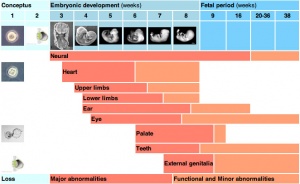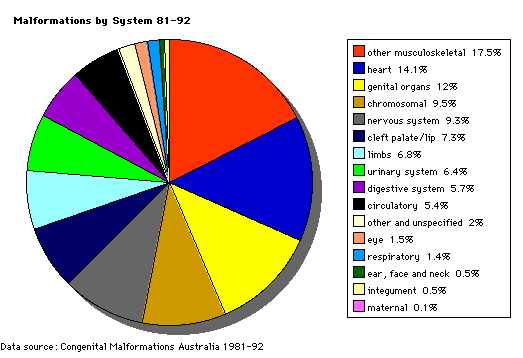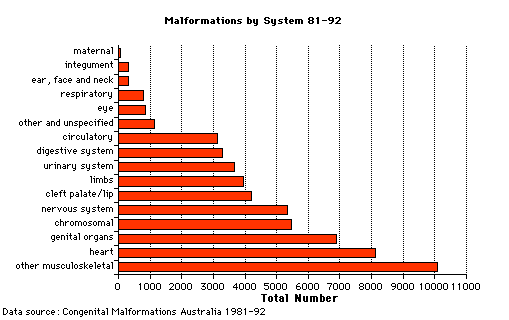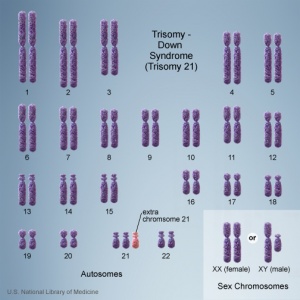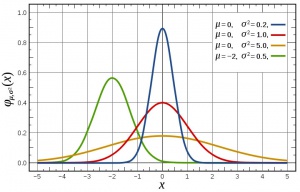Foundations Practical - Critical Periods
Foundations Practical: Introduction | Week 1 and 2 | Week 3 and 4 | Week 1 to 8 | Week 9 to 36 | Neonatal | Critical Periods | Additional Resources | Quiz
Abnormal Development
We have now had a very quick trip through more than 9 months of development in nearly 2 hours. Before we finish it is worth thinking about times in development when things may go wrong.
Environment Effects
- These are developmental times (stages) sensitive to insult, be aware of these times, the causes and the potential effects.
Research has identified many environmental factors now known to negatively impact upon normal development (teratogens) and we have also discovered key factors required for normal development (maternal diet).
Maternal diet, such as folate and iodine, has key roles to play in normal development.
Fetal Alcohol Syndrome (FAS) facial features[1] This disorder was clinically described (USA) in humans about 30 years ago (1973), while historically alcohol's teratogenic effects were identified in the early 20th century in a mix with the prohibition cause of the period.
Critical Periods
Critical periods of development refer to times when genetic or materal effects can impact upon the developmental process. The timing of these effects will impact on different systems at different times.
| Critical Periods of Human Development | ||||||||||||||||||||
|---|---|---|---|---|---|---|---|---|---|---|---|---|---|---|---|---|---|---|---|---|
| Conceptus | Embryonic development (weeks) | Fetal period (weeks) | ||||||||||||||||||

|
||||||||||||||||||||
| Neural | ||||||||||||||||||||
| Heart | ||||||||||||||||||||
| Upper limbs | ||||||||||||||||||||
| Lower limbs | ||||||||||||||||||||
| Ear | ||||||||||||||||||||
| Eye | ||||||||||||||||||||
| Palate | ||||||||||||||||||||
| Teeth | ||||||||||||||||||||
| External genitalia | ||||||||||||||||||||
| Loss | Major abnormalities | Functional and Minor abnormalities | ||||||||||||||||||
| ||||||||||||||||||||
Links: Embryonic Development | Timeline human development | Movie - Human Development annotated cartoon | Human - critical periods | Human Abnormal Development
Systems with long periods of development or complex developmental origins are more susceptible to developmental abnormalities.
- Which systems take a long time to develop?
- Which systems are complex in origin?
Australian Statistics
Australian Congenital Anomalies Monitoring System (ACAMS) contains data based on notifications of major congenital anomalies to birth defects registers in New South Wales, Victoria, Western Australia and South Australia and on data collected on congenital anomalies in Queensland, Tasmania and the Australian Capital Territory. Information is included on live births and stillbirths of 20 weeks gestational age or more or 400 grams birthweight or more (including induced abortions) with a congenital anomaly. Congenital anomalies are coded using the British Paediatric Association Classification of Diseases (ICD-9-BPA), which is based on the International Classification of Diseases, 9th Revision (ICD-9). ACAMS
| USA Statistics | ||||||||||||||||||||||||||||||||||||||||||||||||||||||||||||||||||||||||
|---|---|---|---|---|---|---|---|---|---|---|---|---|---|---|---|---|---|---|---|---|---|---|---|---|---|---|---|---|---|---|---|---|---|---|---|---|---|---|---|---|---|---|---|---|---|---|---|---|---|---|---|---|---|---|---|---|---|---|---|---|---|---|---|---|---|---|---|---|---|---|---|---|
| ||||||||||||||||||||||||||||||||||||||||||||||||||||||||||||||||||||||||
Genetic
With increasing maternal age comes the increased risk of age related genetic abnormalities, in particular the most common chromosomal abnormality (aneuploidy) trisomy 21.
In order to detect some genetic abnormalities many countries offer genetic screening programs that include maternal serum screening (MSS, for detection of Down's syndrome and neural tube defects), embryonic and newborn screening (for phenylketonuria (PKU), hypothyroidism, cystic fibrosis and metabolic disorders).
Developmental Origins of Health and Disease
| The fetal period is also potentially sensitive to environmental effects that impact upon interuterine growth.
This is now known as the Developmental Origins of Health and Disease (DOHaD). |
Additional Information
| Additional Information - Content shown under this heading is not part of the material covered in this class. It is provided for those students who would like to know about some concepts or current research in topics related to the current class page. |
Australian Congenital Anomalies Monitoring System
| Congenital Anomalies in Australia 2002-2003 |
|---|
Congenital anomalies in Australia 2002-2003[2] was published in 2008 as part a new revised series on 33 selected congenital anomalies also monitored internationally by the International Clearinghouse of Birth Defects Surveillance and Research.
|
| External Links Notice - The dynamic nature of the internet may mean that some of these listed links may no longer function. If the link no longer works search the web with the link text or name. Links to any external commercial sites are provided for information purposes only and should never be considered an endorsement. UNSW Embryology is provided as an educational resource with no clinical information or commercial affiliation. |
International Classification of Diseases
The International Classification of Diseases version 11 ( ICD-11) is the standard diagnostic tool for epidemiology, health management and clinical purposes. This includes the analysis of the general health situation of population groups. It is used to monitor the incidence and prevalence of diseases and other health problems.
Terms
Note - linked terms in the list below are external resources to the current class content.
- folate/folic acid - (Latin, folium = leaf) (= Folate, Pteroylglutamic acid) A water soluble vitamin, found in many fruits (particularly oranges, berries and bananas), leafy green vegetables, cereals and legumes, which can prevent neural tube defects (NTDs). The cellular roles of folate include: DNA synthesis, amino acid metabolism and methylation of genes, proteins and lipids via S-adenosylmethionine-mediated one-carbon transfer reactions. (More? folate)
- iodine - required for brain development.
- teratogen - (Greek, teraton = monster) Any agent that causes a structural abnormality following exposure during pregnancy. The overall effect depends on dosage and time of exposure. Absolute risk - the rate of occurrence of an abnormal phenotype among individuals exposed to the agent. (e.g. fetal alcohol syndrome) Relative risk - the ratio of the rate of the condition among the exposed and the non-exposed. (e.g. smokers risk of having a low birth weight baby compared to non-smokers) A high relative risk may indicate a low absolute risk if the condition is rare.
Foundations Practical: Introduction | Week 1 and 2 | Week 3 and 4 | Week 1 to 8 | Week 9 to 36 | Neonatal | Critical Periods | Additional Resources | Quiz
Glossary: A | B | C | D | E | F | G | H | I | J | K | L | M | N | O | P | Q | R | S | T | U | V | W | X | Y | Z | Numbers
Cite this page: Hill, M.A. (2024, April 16) Embryology Foundations Practical - Critical Periods. Retrieved from https://embryology.med.unsw.edu.au/embryology/index.php/Foundations_Practical_-_Critical_Periods
- © Dr Mark Hill 2024, UNSW Embryology ISBN: 978 0 7334 2609 4 - UNSW CRICOS Provider Code No. 00098G
- ↑ Wattendorf DJ & Muenke M. (2005). Fetal alcohol spectrum disorders. Am Fam Physician , 72, 279-82, 285. PMID: 16050451
- ↑ Abeywardana S & Sullivan EA 2008. Congenital anomalies in Australia 2002–2003. Birth anomalies series no. 3 Cat. no. PER 41. Sydney: AIHW National Perinatal Statistics Unit.
